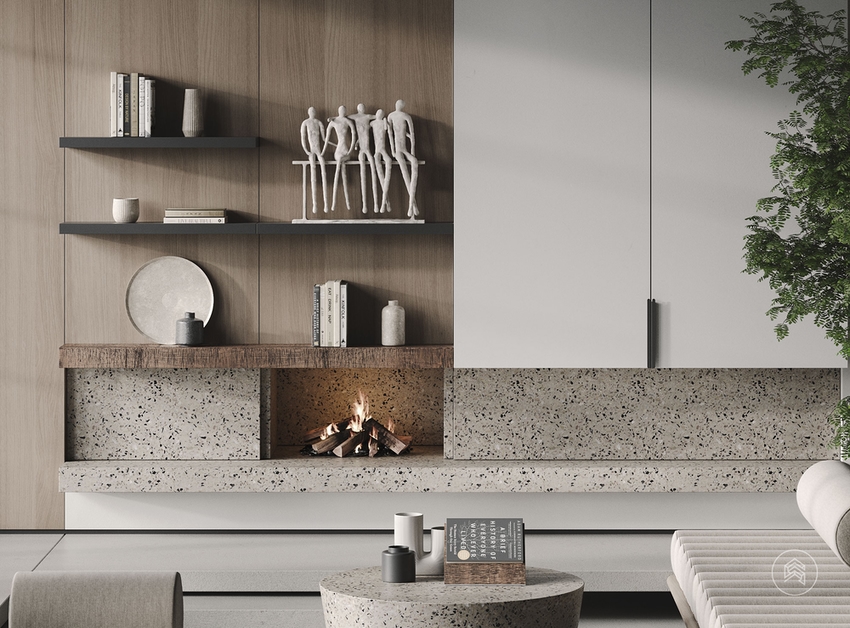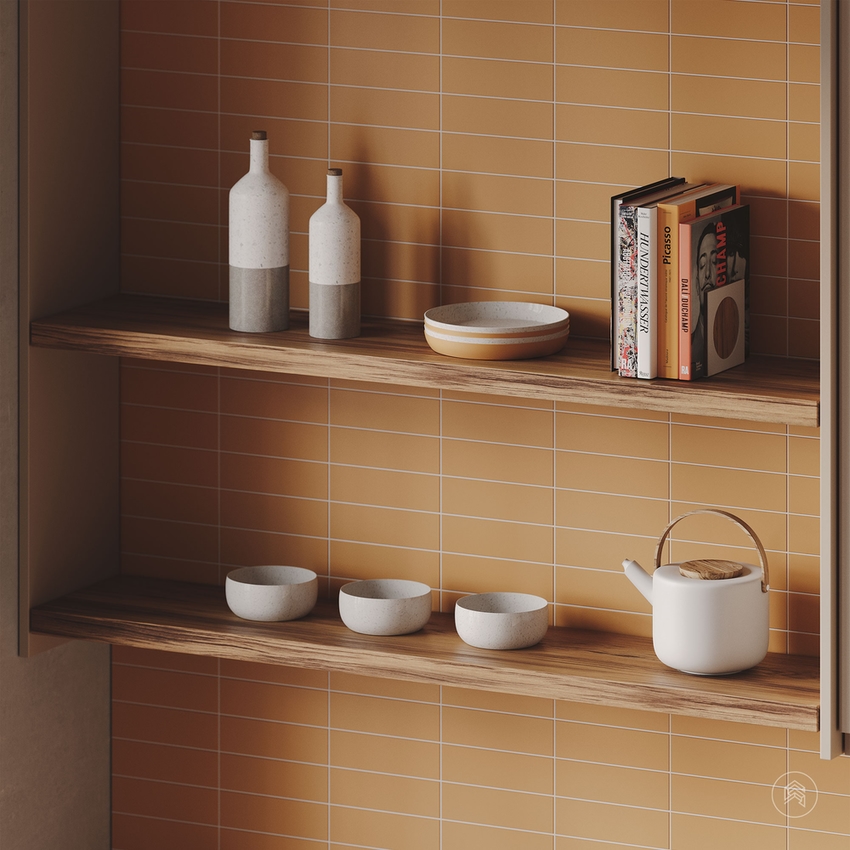Floating shelves were made for minimalist interiors. Mounted with hidden brackets and designed to maximize space, these dapper, unpretentious shelves make the perfect design choice for the minimalist aesthetic, a timeless style that embraces elegant simplicity, natural materials, and open space.
“Floating shelves create an open feeling and provide an opportunity to add some visual interest to a space; their success in a modern setting is all in how they’re styled,” says Debby Katz of Debby Katz Interiors, a residential design firm in Fairfield County, Connecticut with projects spanning the New York metropolitan area. We leaned on Katz’s expertise to give Shelfology enthusiasts some great tips and advice for designing a minimalist retreat you’ll love to come home to.
Minimalism Interior Design
The minimalist design aesthetic is intended to inspire joy and foster peace and relaxation. This is achieved by selecting well-intentioned pieces with clean lines and eliminating unnecessary objects and overly decorative ornamentation. In a minimalist interior, one often finds sparse walls with a single focal point. Rooms are light and airy, feature open layouts, and are enhanced by sculptural forms, sunlight, and natural materials such as wood, concrete, and stone. The goal: to create a space that evokes peace, tranquility, and relaxation through a natural, well-edited environment.
Light, shape, and form denote beauty in this decluttered elegant space stripped down to the bare essentials. Furniture, storage, and decor pieces are thoughtfully chosen such as a painting in a seating area or a sculptural vase on a floating shelf or mantel.
“Minimalist design embraces a pared-down aesthetic [featuring] clean lines and simplicity of form with a focus on a simple color palette and the subtle use of texture,” says Katz.
“The hallmark [of minimalist decor involves] the use of reductive design elements that eschew ornamentation and clutter; it also requires a keen eye for well-designed, comfortable pieces since each item is important.”
Minimalist Decor Past and Present
Originating during the 1920s modernist art movement, minimalism emerged as an interior design aesthetic in the 1960s and is still popular today. Its foundation is based on the concept “less is more,” coined by Mies van der Rohe, a modernist architect and furniture designer who designed the iconic Barcelona Chair found in many modern homes.
Although the minimalist aesthetic is deeply rooted in Japanese-inspired interiors, according to Katz, it isn’t limited to one interior style. “Mid-century modern, contemporary, Scandinavian, and what I call Modern Mountain all work with minimalist design goals.”
Read on for six tips that will help you get into the minimalist mindset and design the sanctuary of your dreams.
1. Opt for a Neutral Color Palette

Minimalist decor features neutral color palettes—black, white, gray, beige, and greige––that serve as a canvas for your composition when selecting paint and decor. The following neutral paint colors can help you create a backdrop for your canvas:
- Agreeable Gray by Sherwin Williams
- Repose Gray by Sherwin Williams
- Wind’s Breath by Benjamin Moore
- Accessible Beige by Sherwin Williams
You can also integrate a pop of color into your space as an accent hue which creates a unique contrast. “The minimalist trend is all about soothing (not boring) spaces that highlight the use of space and natural light,'' Katz says. “Natural elements are used to create harmony and a sense of well-being, while also adding pops of color and texture.”
Adding a pop of color to your decor with a vase, toss pillow, or throw blanket provides an opportunity to change the mood and celebrate a new season. But keep it subtle. Use autumn hues like orange, maroon, or gold in fall. Come June, swap out decor accents for a summer hue like yellow, blue, or lime green.
Monochromatic Color Palettes
If you’re set on color for your minimalist interior, consider using a monochromatic color palette. These palettes feature one base color with a variation of shades and tones. For example, beige would mix with an espresso leather sofa, mocha floating shelves, and a creamy white shade for your door and window trim.
2. Leave Plenty of Room for White Space

Leaving a lot of white space (and it doesn’t need to be the color white) on walls and floors provides an authentic way to showcase your favorite pieces while still leaving space for the room to breathe. Instead of having a room crammed with furniture and decor, consider choosing minimal furniture pieces and a few floating shelves to display items you love.
This will allow you to make meaningful items such as family photos, books, or artwork serve as a focal point and take center stage. It will also create order and harmony in your space and eliminate any distractions.
3. Create a Cohesive Look with Floating Shelves

“The items on floating shelves can unify a space by connecting with colors and textures that already exist in the room,” says Katz. “Their success in a modern setting is all in how they’re styled.”
“[Floating shelves] can bring balance by incorporating differently scaled items, a burst of color, or some texture in a room that lacks some of these elements.”
“[However,] keep it simple––be judicious about what you put on shelves,'' says Katz. “A few thoughtfully selected, high-quality pieces will keep your floating shelves from looking kitschy and cluttered.”
“Consider simple, well-designed pieces such as pottery or sculpture, a few interesting books, a plant, or a piece of art, and an intentional use of negative space,” suggests Katz. “Keeping them thoughtfully curated and not overly cluttered is key.”
4. Pick Floating Shelves That Jive with Minimalist Decor

In a minimalist interior, you’ve got options. You can choose floating shelves in a similar color to the wall. To coordinate shelving with a white wall, choose a white matte floating shelf. To create contrast, opt for a dark brown floating shelf to coordinate with a light beige wall color. Or select a dark gray or black floating shelf to complement light gray or white walls.
If you have wooden surfaces like a rustic oak countertop or dining table––or architectural details like exposed wood beams—there’s nothing better than hardwood floating shelves to match your decor.
Thinking you want a pop of color to create contrast? Whether it’s a subdued or bright hue, you can choose from more than 30 colors at Shelfology.
5. Add Warmth and Texture with Organic Fabrics and Textiles

A minimalist interior doesn’t need to be stark and cold even with a black, white, and gray color palette. By implementing natural fibers and textiles into your decor in your bedding, window coverings, area rugs, and accent pillows, you can make your space warm and inviting.
“Organic materials and textures are great ways to warm up a space,” says Katz. “Wool rugs, an alpaca throw, warm woods, and textures counter the use of glass and steel that is often present in more minimalist spaces.”
Other decor items that can warm up your space include the following:
- Grasscloth wallpaper that makes a great feature wall background for floating shelves
- Handwoven pillows and bamboo roman shades
- A cotton, jute, or linen area rug
6. Metal Shelving in Minimalist Design
Metal shelves are no longer designed for commercial spaces. They’re found in a variety of modern residential design environments including minimalist spaces that feature materials like wood, stone, and glass. Shelfology’s Tromso All-Steel floating shelves, for example, aren’t only striking and create visual appeal, they’re sturdy enough to hold 50 pounds of weight at each attachment point when properly mounted to a stud.
Steel floating shelves can even warm up an interior when you choose the right color or finish such as copper, bronze, champagne, or a powder-coated finish. Metal shelves can look great with coordinating light fixtures or make a room with a hardwood countertop and furnishings feel lighter.
The Takeaway on Minimalist Decor and Floating Shelves
Fusing modern simplicity with a pared-down style, the union of floating shelves and minimalist decor make the perfect match for a timeless design statement that inspires joy.




